John Anderson | |
|---|---|
 Portrait of John Anderson | |
| Personal details | |
| Born | 23 May 1805 |
| Died | 25 March 1855 |
John Anderson (1805–1855) was a Scottish missionary and the founder of the mission of the Free Church of Scotland at Madras, India.
John Anderson | |
|---|---|
 Portrait of John Anderson | |
| Personal details | |
| Born | 23 May 1805 |
| Died | 25 March 1855 |
John Anderson (1805–1855) was a Scottish missionary and the founder of the mission of the Free Church of Scotland at Madras, India.
John Anderson was born at Craig Farm, Kirkpatrick Durham, in Galloway, on 23 May 1805. [1] He was the eldest son in a family of nine, his father being blind. He received the rudiments of his education in the parish schools, and in his twenty-second year entered the University of Edinburgh, where he obtained prizes in Latin and in moral philosophy, [2] distinguishing himself by his facility in Latin composition, and studying theology and church history under Thomas Chalmers and David Welch. [3] During part of this period he taught at the Mariners' School at Leith; was tutor in the family of Alexander Cowan, Callander, and at Troqueer Holm on the Nith [4]
Anderson was licensed by the Presbytery of Dumfries on 3 May 1836. He volunteered for service in India (impelled chiefly by Dr Duff's missionary address to the General Assembly). He was appointed by the Foreign Mission Committee 28 June, and ordained on 13 July 1836. Travelling to India, he sailed in the Scotia on 13 August 1836. He arrived at Calcutta on 27 December and Madras 22 February 1837. On 3 April he took charge of St Andrew's School (established by two Scottish chaplains, Matthew Bowie and George James Lawrie in 1835) beginning his labours as a missionary with fifty-nine Hindu boys and young men - the nucleus of the Madras Christian College. [4]

The branch of missionary work to which Anderson devoted himself, was education. [2] At that time the standard of education among the natives of the Madras presidency was very low. Anderson's object, as stated in the prospectus of the first mission school opened by him at Madras, was ‘to convey through the channel of a good education as great an amount of truth as possible to the native mind, and especially of Bible truth,’ the ultimate aim being ‘that each of these institutions shall be a normal seminary in which teachers and preachers may be trained up to convey to their benighted countrymen the benefit of a sound education and the blessings of the gospel of Christ.’ Anderson laid great stress upon education and native preachers in all missionary effort. The first school established by Anderson, which formed the nucleus of the institution now known as the Madras Christian College, speedily acquired a high reputation. The number of pupils rapidly increased, although the school was on several occasions almost broken up on the conversion to Christianity of some of the pupils, and also by the admission of pupils of low caste. Notwithstanding these difficulties and the establishment of a very efficient government school, in which the instruction given was purely secular, the mission school prospered, and in the course of a few years branch mission schools were established in the town of Madras and in some of the principal towns in the neighbouring districts. One of the leading features in Anderson's method of instruction was the practice of making the pupils question each other on the subject of the lesson, a practice which, at that time, was new, at all events, in India. In 1841 the first native converts, two in number, were baptised, and in 1846 these two converts and one other were licensed as preachers, and were ordained in 1851. Anderson never looked forward to numerous conversions as the immediate result of mission work. [3]
In 1839 Anderson was joined by a second missionary, Reverend Robert Johnston, [2] who proved a most valuable coadjutor. In the course of a few years the number of Scottish missionaries was increased to four.
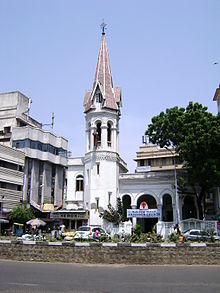
In 1843, on the Disruption of the church of Scotland, Anderson and his colleagues joined the Free Church, and thenceforward the mission was carried on in connection with that church. The subject of female education soon attracted Anderson's attention. There was no difficulty in securing the attendance of girls of the lower castes; but in the case of native caste girls the difficulty was, and still is, very great. Indian girls marry early, and native parents see none of the material benefits to be derived from their education, which induce them to send their sons to mission schools, even at the risk of their being led to change their religion. But these obstacles were gradually overcome in some measure, and before Anderson's death seven hundred Hindu and Mohammedan girls, the majority of the former belonging to families of good caste, were under instruction in the schools of the mission. In this branch of his work Anderson was greatly helped by Mrs. Anderson. Anderson revisited Scotland in 1849, when he was accompanied by P. Bajahgopaul, one of his first converts. He returned to India in December 1850 and died on 25 March 1855. [3] [4]
Anderson died at Madras in March 1855, after a short illness. He had laboured indefatigably for eighteen years at the work for which he had been set apart; only once during that period revisiting his native land, whither he was accompanied by the Rev. P. Rajahgopál, one of his first converts. His constitution, naturally strong, had become enfeebled by his incessant toils and anxieties in a debilitating climate. [3] His work for India was entirely educational. He established schools in various centres, and greatly helped by his wife, devoted himself to the instruction of native girls of all castes and creeds giving special attention to those of higher caste as being more difficult to draw within Christian influences. Before his death seven hundred Hindu and Mohammedan girls were in attendance at his mission schools. [4]
The Anderson Church, Chennai is named after him. [5]
He married 29 January 1847, Margaret Locher (died without issue), a Swiss lady from Zurich, appointed in 1845 missionary at Madras of the Ladies' Association of the Church of Scotland. She joined the Free Church in April 1846. [4]

The Free Church of Scotland is a Scottish denomination which was formed in 1843 by a large withdrawal from the established Church of Scotland in a schism known as the Disruption of 1843. In 1900, the vast majority of the Free Church of Scotland joined with the United Presbyterian Church of Scotland to form the United Free Church of Scotland. In 1904, the House of Lords judged that the constitutional minority that did not enter the 1900 union were entitled to the whole of the church's patrimony ; the residual Free Church of Scotland acquiesced in the division of those assets, between itself and those who had entered the union, by a Royal Commission in 1905. Despite the late founding date, Free Church of Scotland leadership claims an unbroken succession of leaders going back to the Apostles.
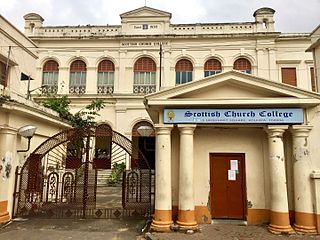
Scottish Church College is a college affiliated by Calcutta University, India. It offers selective co-educational undergraduate and postgraduate studies and is the oldest continuously running Christian liberal arts and sciences college in Asia. It has been rated (A) by the Indian National Assessment and Accreditation Council. Students and alumni call themselves "Caledonians" in the name of the college festival, "Caledonia". The Scottish Church College has been embellished as GRADE-I Heritage Building on 8th November, 2023.

Alexander Duff, was a Scottish missionary in India; where he played a large part in the development of higher education. He was a Moderator of the General Assembly and convener of the foreign missions committee of the Free Church of Scotland and a scientific liberal reformer of anglicized evangelism across the Empire. He was the first overseas missionary of the Church of Scotland to India. On 13 July 1830 he founded the General Assembly's Institution in Calcutta, now known as the Scottish Church College. He also played a part in establishing the University of Calcutta. He was twice Moderator of the Free Church of Scotland in 1851 and 1873, the only person to serve the role twice.

Madras College, often referred to as Madras, is a Scottish comprehensive secondary school located in St Andrews, Fife. It educates over 1,400 pupils aged between 11 and 18 and was founded in 1833 by the Rev. Dr Andrew Bell.
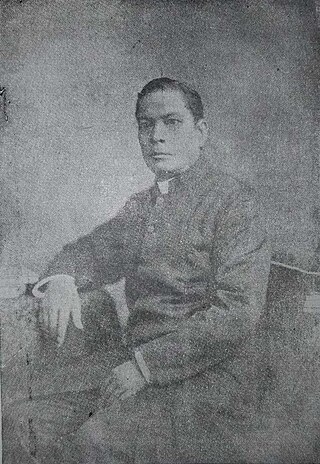
Reverend Lal Behari Day was an Indian writer and journalist, who converted to Christianity, and became a Christian missionary himself.
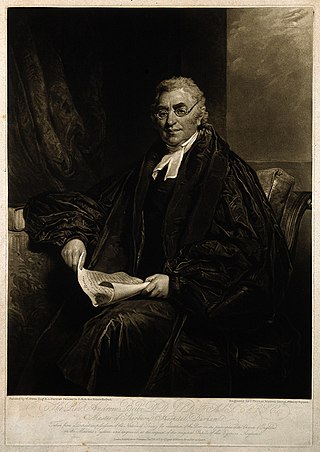
Andrew Bell was a Scottish Anglican priest and educationalist who pioneered the Madras System of Education in schools. He was the founder of Madras College, a secondary school in St Andrews, and helped fund other schools.
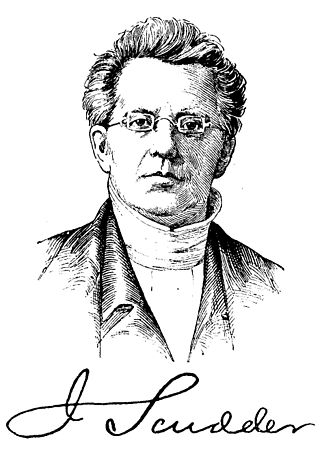
Members of the Scudder family have worked as medical missionaries in South India.

John Wilson FRS was a Scottish Christian missionary, orientalist, ethnographer, and Christian minister. He was the member of The Royal Society of London for Improving Natural Knowledge.

John Anderson Graham was a Scottish minister and the first missionary from Young Men's Guild sent to North Eastern Himalayan region Kalimpong—then in British Sikkim, currently in West Bengal.

William Miller was a Scottish educationalist and Free Church of Scotland missionary to Madras. He was also a member of Madras Legislative Council for four terms—in 1893, 1895, 1899, and 1902.
Goodwill's Girls School is located at Promenade Road, Fraser Town, Bangalore Cantonment. Formerly known as the Wesleyan Tamil School, the school was renamed after Rev. Fred Goodwill, a British Missionary and Tamil scholar, who served as the manager of the school, in his capacity as superintendent of the Wesleyan Tamil Mission, Bangalore and Kolar Gold Fields.

The Tranquebar Mission was established in 1706 by two German missionaries from Halle namely, Bartholomäus Ziegenbalg and Heinrich Plütschau. Ziegenbalg and Plütschau responded to the appeal of King Frederick IV of Denmark to establish a mission for the natives, living in the Danish East India Company colony of Tranquebar. The mission was responsible for the printing and publication of the Bible in the Tamil language. In 2006, the 300 years anniversary of the mission was celebrated by the Tamil Evangelical Lutheran Church (TELC), with many international delegates in attendance. A monument to acknowledge 300 years of the mission was raised by the TELC on this occasion.
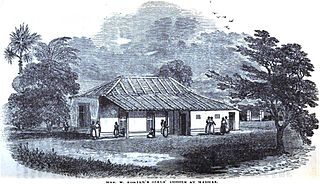
The Bentinck Higher Secondary School is located on Jermiah Road, Vepery, Chennai, near the Vepery Police Station. The school is considered to be one of Chennai's best girls' schools and is aided by Government of Tamilnadu. The school offers education to girls in English, Tamil and Telugu mediums till class 10. English and Tamil medium in class 11 and 12. The school is also known as simply the Bentinck School or Bentinck Vepery. The school is 185 years old. Started in 1837 with just 21 students, the school now has more than 2000 students.
George Smith CIE FRGS LLD was a 19th-century Scottish historian and geographer who spent his working life in India. He was father to a family of eminent figures.
John Fordyce (1819–1902) was a Christian missionary, evangelical minister and administrator who launched the female education initiative in India known as the Zenana Missions. He has been credited with introducing the rickshaw to India.
Thomas Smith was a Scottish missionary and mathematician who was instrumental in establishing India's zenana missions in 1854. He served as Moderator of the General Assembly of the Free Church of Scotland 1891/92.

Benjamin Henry Arthur Margoschis was a Protestant Christian missionary in India. He served the Society for the Propagation of the Gospel in Foreign Parts (SPG) as an overseas missionary in India. The inhabitants of Nazareth, a small town in Tamil Nadu, called him the "Father of Nazareth" and Margoschis Aiyar. Aiyar means clergyman in the native language. Reverend Margoschis was responsible for the development of the small town of Nazareth, which is situated at the southern part of Tamil Nadu, India.

Kali Charan Chatterjee D. D. (1839–1916), also spelt as Kali Charan Chatterji or K.C. Chatterjea, was a Bengali Christian missionary who worked with the American Presbyterian Mission in Hoshiarpur, Punjab and served as the first moderator of the Presbyterian Church in India upon its formation in 1904.

William Spence Urquhart was a Scottish religious scholar, Christian missionary and academic in India. He influenced among others one of his college students, the religious leader A. C. Bhaktivedanta Swami Prabhupada.